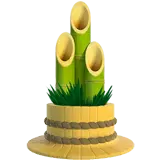Daffodil Narcissus 'Gemini Girl' (2)

ABOUT
Narcissus 'Gemini Girl' is a captivating flowering plant characterized by its striking blooms. The flowers of 'Gemini Girl' are usually displayed in a stunning dual-toned palette. Each bloom typically features a central cup, often called a corona, surrounded by a ring of six petal-like tepals, which are usually broader and flatter than the cup. The corona of 'Gemini Girl' tends to be a vibrant, contrasting hue compared to the outer tepals, which may be a softer color. The petals and cup can present different textures, with the cup-shaped center possibly exhibiting a more crinkled or ruffled appearance. The foliage of 'Gemini Girl' consists of long, slender, green leaves that grow at the base of the plant. These leaves emphasize the bright colors of the blossoms by providing a lush green backdrop. The plant boasts multiple flowers per stem, creating an impressive and eye-catching display. As a member of the Narcissus family, 'Gemini Girl' shares the common name of daffodil with its kin. The overall look of the plant is cheerful and spring-like, making it a favored variety for gardeners looking to add a splash of color to their gardens in the blooming season. Like many daffodils, the 'Gemini Girl' would typically emerge after the cold of winter, heralding the approach of warmer days with its vibrant blooms.
About this plant
 Names
NamesSynonyms
Daffodil, Narcissus, Jonquil.
Common names
Narcissus 'Gemini Girl'
 Toxicity
ToxicityTo humans
The Narcissus, commonly known as the daffodil, is toxic when ingested. All parts of the daffodil contain lycorine and other alkaloids which can cause poisoning. Symptoms of narcosis poisoning in humans can include nausea, vomiting, abdominal pain, and diarrhea. In severe cases, ingestion can lead to cardiac arrhythmias, low blood pressure, tremors, and convulsions. Handling the bulbs can also cause skin irritation for sensitive individuals.
To pets
The daffodil is toxic to pets. The ingestion of any part of the plant, especially the bulbs, can cause severe symptoms due to the presence of lycorine and other toxic alkaloids. Symptoms in pets can include vomiting, salivation, diarrhea, abdominal pain, cardiac arrhythmias, and respiratory depression. In severe cases, it may cause seizures or a drop in blood pressure, and can be potentially fatal if not treated promptly.
 Characteristics
CharacteristicsLife cycle
Perennials
Foliage type
Deciduous
Color of leaves
Green
Flower color
Yellow
Height
1 foot 6 inches (45-60 cm)
Spread
1 foot 6 inches (45-60 cm)
Plant type
Bulb
Hardiness zones
3-9
Native area
Europe
Benefits
 General Benefits
General Benefits- Aesthetic Appeal: 'Gemini Girl' Daffodil adds vibrant color and beauty to gardens and landscapes with its unique double blooms featuring a mix of white and yellow colors.
- Spring Blossoming: As a spring-flowering bulb, it offers early season color, often when few other plants are in bloom.
- Low Maintenance: Daffodils are easy to care for, requiring minimal upkeep once planted.
- Cold Hardiness: The 'Gemini Girl' Daffodil is tolerant to cold climates and can survive winter conditions in many regions.
- Perennial Growth: It is a perennial, returning year after year to grace gardens with its presence.
- Pest Resilience: Daffodils are generally resistant to deer, rabbits, and other garden pests.
- Easy Propagation: These plants can be easily propagated by bulb division, allowing gardeners to expand their display or share with others.
 Medical Properties
Medical PropertiesThis plant is not used for medical purposes.
 Air-purifying Qualities
Air-purifying QualitiesThis plant is not specifically known for air purifying qualities.
 Other Uses
Other Uses- Dried Flower Arrangements: The cut flowers of Narcissus 'Gemini Girl' can be dried and used in floral arrangements, providing a lasting decoration with a touch of spring.
- Photography Subject: With its striking colors and form, this narcissus can be an excellent subject for photographers, especially those specializing in botanical and nature photography.
- Wedding Decor: Narcissus 'Gemini Girl' can be incorporated into wedding bouquets, centerpieces, or as part of the venue decoration because of its unique beauty and symbolism of new beginnings.
- Crafts: The blossoms can be used in various craft projects including making pressed flower art, bookmarks, or even incorporated into homemade paper.
- Education: Botanical gardens and schools can use Narcissus 'Gemini Girl' as a living example to educate people about plant biology, hybridization, and horticulture practices.
- Garden Competitions: Horticulturists might cultivate this narcissus for competitive flower shows, aiming to produce perfect specimens that reflect the variety’s qualities.
- Aromatherapy: While not used as an essential oil, the fresh cut flowers of Narcissus 'Gemini Girl' can be used to naturally fragrance indoor spaces with their subtle scent.
- Eco-friendly Dye: The flowers and bulbs might be used to create natural dyes for fabric, yielding colors reflective of the flower itself.
- Perfume Inspiration: While not directly used in perfumery, the scent profile of Narcissus 'Gemini Girl' can inspire perfume notes, particularly in spring-themed fragrances.
- Landscape Design: This variety can serve a particular visual interest in landscape design because of its unique coloration and form, often used to create focal points in garden beds.
Interesting Facts
 Feng Shui
Feng ShuiThe daffodil is not used in Feng Shui practice.
 Zodiac Sign Compitability
Zodiac Sign CompitabilityThe daffodil is not used in astrology practice.
 Plant Symbolism
Plant Symbolism- Rebirth and Renewal: The Narcissus 'Gemini Girl', commonly known as daffodil, often blooms in early spring, symbolizing the renewal of life and the end of winter.
- Inspiration and Creativity: With its bright flowers and unique form, daffodils represent new beginnings and the creative inspiration that spring brings.
- Self-Love: The daffodil's association with the Greek myth of Narcissus, who fell in love with his own reflection, ties it to themes of self-love and self-respect.
- Prosperity: Daffodils are often associated with wealth and prosperity, owing to their rich, golden blooms that resemble coins or gold.
- Hope: The bright yellow bloom of the daffodil is a cheerful symbol of hope and positive outlooks for the future.
 Water
WaterFor daffodils, which is the most common name for Narcissus 'Gemini Girl', watering should be consistent but moderate. They require a good drink during their growing season, especially in the spring. Water thoroughly once a week with about one inch of water, which approximately equates to half a gallon for a standard-sized plant. Avoid waterlogging as daffodils prefer well-drained soil. Reduce watering once the flowers have died back and the foliage has started to yellow, signaling the end of their growth cycle.
 Light
LightDaffodils thrive best in full sunlight to partial shade. The ideal spot for them is an area that receives at least six hours of direct sunlight per day. They can tolerate some light afternoon shade, especially in hotter climates. Avoid deep shade locations as insufficient light can inhibit flowering.
 Temperature
TemperatureDaffodils are hardy and can tolerate a range of temperatures but perform best in temperate climates. They can survive minimum temperatures as low as 20°F but prefer a range between 50°F and 70°F for optimal growth. Daffodils are spring bloomers, so they are well-adapted to the cooler temperatures of early spring and can even tolerate light frosts.
 Pruning
PruningPruning daffodils involves deadheading flowers after they fade, which encourages the plants to direct energy into bulb growth instead of seed production. Cut back the foliage only after it has yellowed and died down naturally, which is usually six weeks after blooming. Pruning too early can harm the bulb's ability to store energy for the next season.
 Cleaning
CleaningAs needed
 Soil
SoilDaffodil 'Gemini Girl' thrives in well-drained soil with a pH range of 6.0 to 7.0. For the best soil mix, incorporate compost or well-rotted manure to enrich the soil and ensure good drainage, possibly using a mix of loam, sand, and peat. Plant the bulbs about 6 inches deep and about 4-6 inches apart.
 Repotting
RepottingDaffodils like 'Gemini Girl' generally do not need to be repotted often; they can be left undisturbed for several years. Repotting or dividing is usually only necessary if the bulbs become overcrowded or if their flowering performance declines, which might be every 3 to 5 years.
 Humidity & Misting
Humidity & MistingDaffodil 'Gemini Girl' does not require high humidity levels and will tolerate the average humidity found in most outdoor garden environments. They do not have specific humidity requirements as long as they are planted in well-draining soil to prevent bulb rot from excess moisture.
 Suitable locations
Suitable locationsIndoor
Place Daffodil 'Gemini Girl' near a sunny window and keep soil moist.
Outdoor
Plant in well-drained soil with full or partial sun exposure.
Hardiness zone
3-9 USDA
 Life cycle
Life cycleThe life of Narcissus 'Gemini Girl', commonly known as Daffodil, begins with a period of dormancy where the bulb lies underground typically during summer months. As cooler temperatures arrive in autumn, root development commences, preparing the plant for growth. Entering winter or early spring, shoots emerge from the bulb, and the growth of leaves and flower stalks takes place, utilizing stored energy within the bulb. The plant blooms, producing the characteristic yellow or white flowers, often with a contrasting central cup, which is the reproductive phase involving pollination potentially by insects. After flowering, the plant goes through seed set if pollination has occurred, although many cultivators maintain daffodils through bulb division instead of seeds. The life cycle completes as the foliage dies back into the bulb, which then reenters dormancy until the next growing cycle.
 Propogation
PropogationPropogation time
Spring-Early Summer
Propogation: Narcissus 'Gemini Girl', commonly known as daffodil, can be propagated most effectively through division of its bulbs. The best time for this is after the foliage has died back and the plant has gone dormant, typically in late summer to early fall. To propagate, carefully dig up the clump of bulbs and gently separate them by hand, ensuring that each division has at least one growing point or bud. Replant the divisions immediately at a depth of about 6 inches (15 cm) and spaced approximately 6 inches (15 cm) apart to allow room for growth. Water the newly planted bulbs well to help establish them. This method of propagation allows gardeners to increase their stock of daffodils and maintain the genetic characteristics of the 'Gemini Girl' cultivar.









